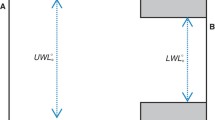Abstract
In this paper, we propose to change the traditional monitored statistic in a control chart p, by changing the sampling proportion \({\hat{p}}\) to a new statistics denoted as \({\tilde{p}}\). We aim to minimize problems in designing the control chart p for high quality processes when only a small sample size is available. The idea of the new statistics is simple, as it involves taking two independent samples of a Bernoulli population. From each sample, the sampling proportion is calculated, and the new statistic to monitor is the weighted mean of the sampling proportion of each sample employed to weight the overall sampling proportion. We note that the control chart p that employs the new \({\tilde{p}}\) statistic provides more in-control values of average run length closer to the usual fixed value of 370 than the traditional statistic, that is, the sampling proportion. Numerical examples illustrate the new proposal.
Similar content being viewed by others
References
Böhning D, Viwatwongkasem C (2005) Revisiting proportions estimators. Stat Methods Med Res 14: 147–169
Boswell MT, Ord JK, Patil GP (1979) Chance mechanisms underlying univariate distributions, statistical ecology, 4. In: Ord JK, Patil GP, Taillie C (eds) Statistical distributions in ecological work. International Co-operative Publishing House, Fairland, MD, pp 1–156
Carlin BP, Louis TA (2000) Bayes and empirical Bayes methods for data analysis. Chapman & Hall, London
Casella G, Berger RL (2001) Statistical inference. Pacific Grove, Duxbury
Chao A (2001) An overview of closed capture–recapture models. J Agric Biol Environ Stat 6: 158–175
Chao A (1998) Capture–recapture. In: Armitage P, Colton T (eds) Encyclopedia of biostatistics, vol 1. Wiley, New York, pp 482–486
Chew V (1971) Point estimation of the parameter of the binomial distribution. Am Stat 25: 47–50
Farz A, Saniga E (2009) A unification and some corrections to Markov chain approaches to develop variable ratio sampling scheme control charts. Stat Pap. doi:10.1007/s00362-009-0288-7 (to appear)
Fisher RA, Mather K (1936) A linkage test with mice. Ann Eugenics, London 7: 265–280
Hook EB, Regal R (1995) Capture–recapture methods in epidemiology: methods and limitations. Epidemiol Rev 17: 243–264
International Working Group for Disease Monitoring and Forecasting (1995a) Capture–recapture and multiple record systems estimation I: history and theoretical development. Am J Epidemiol 142:1047–1058
International Working Group for Disease Monitoring and Forecasting (1995b) Capture–recapture and multiple record systems estimation II: Applications in human diseases. Am J Epidemiol 142:1059–1068
Johnson NL, Kotz S, Balakrishnan N (1992) Univariate discrete distributions. 2nd Edn. Wiley, New York
Kaplan N, Risko K (1982) A method for estimating rates of nucleotide substitution using DNA sequence data. Theor Popul Biol 21: 318–328
Klufa J (2008) Dodge-Roming AOQL plans for inspection by variables from numerical point of view. Stat Pap 49: 1–13
Lipsitz SR, Dear KBG, Laird NM, Molenberghs G (1998) Tests for homogeneity of the risk difference when data are sparse. Biometrics 54: 148–160
Montgomery DC (2001) Introduction to statistical quality control, 4 edn. Wiley, New York
Sánchez-Meca J, Marín-Martínez F (2000) Testing significance of a common risk difference in meta-analysis. Comput Stat Data Anal 33: 299–313
Sankey SS, Weissfeld LA, Fine MJ, Kapoor W (1996) An assessment of the use of the continuity correction for sparse data in meta-analysis. Commun Stat Simul Comput 25: 1031–1056
Santner TJ, Duffy DE (1989) The statistical analysis of discrete data. Springer, Berlin
Seber GAF (1982) The estimation of animal abundance, 2nd edn. Griffin, London
von Collani E, Dräger K (2001) Binomial distribution handbook for scientists and engineers. Birkhäuser/Boston, New York
Whitehead A, Whitehead J (1991) A general parametric approach to the meta-analysis of randomized clinical trials. Stat Med 10: 1665–1677
Author information
Authors and Affiliations
Corresponding author
Rights and permissions
About this article
Cite this article
Ho, L.L., da Costa Quinino, R., Suyama, E. et al. Monitoring the conforming fraction of high-quality processes using a control chart p under a small sample size and an alternative estimator. Stat Papers 53, 507–519 (2012). https://doi.org/10.1007/s00362-010-0356-z
Received:
Accepted:
Published:
Issue Date:
DOI: https://doi.org/10.1007/s00362-010-0356-z




